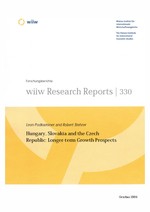Hungary, Slovakia and the Czech Republic: Longer-term Growth Prospects
For about a decade, GDP growth in Central European countries has been consistently faster than in the 'old' EU-15. As a first approximation, one can expect a growth differential of about 2 percentage points to prevail also in the future. This practical rule-of-thumb is broadly consistent with the outcomes of some early attempts at a formal estimation of the longer-term growth rates for the countries considered. The early models underlying those attempts were inspired by the 'New Growth Theory' (NGT) approach (exemplified by Barro and Sala-i-Martin, 1995). This study reviews the available estimates derived from the NGT models and proposes new ones, taking into account the most recent data available. The base-line scenario suggests that over the period 2005-15, per capita GDP will grow on average by 3.6% per year in the Czech Republic, 4.1% in Hungary and 4.6% in Slovakia (with the EU-15 growing by 2.4%). At constant (1999) PPPs, the Czech per capita GDP will attain 71% of the EU-15 level, Hungary’s 63% and that of Slovakia 59%. Apart from estimates for the aggregate GDP levels/growth rates, the study also assesses the likely levels of the future (2015) trade balances, gross capital formation, FDI inflows and stocks.
The second part of the study is concerned with the estimation of changes in the structure of value added and employment, consistent with the 'macro' estimates for the period 2005 15. Although one may expect convergence, in terms of productivity and sectoral composition, to the EU-15 levels, sizeable deviations will remain. Aggregate employment forecasts for 2015 appear to be quite sensitive to the GDP growth rate.
Keywords: New Growth Theory, catch-up, productivity and employment, convergence scenarios
JEL classification: O41, O47, O57
Countries covered: Czechia, Hungary, Slovakia, Visegrad countries
Research Areas: Macroeconomic Analysis and Policy
